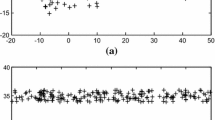Abstract
Generally, spectral clustering (SC) includes two steps. First, the similarity matrix is obtained from the original data, then perform k-means clustering based on the similarity matrix. For k-means algorithm, the choice of initial clustering center limits its clustering performance. To solve this problem, this paper proposes an improved spectral clustering algorithm based on tissue-like P system, called ISCTP. It replaces k-means algorithm in spectral clustering with k-means++ to improve the arbitrariness of initial point selection. k-means algorithm needs to artificially determine the initial clustering center, different clustering centers may lead to completely different results. While k-means++ can effectively refine this disadvantage, the basic idea of k-means++ is that the distance of different clustering centers should be as far as possible. In addition, we combine k-means++ with the tissue-like P system that has unique extremely parallel nature and can greatly improves the efficiency of the algorithm. The experimental results of UCI and artificial datasets prove the effectiveness of our proposed method.
Access this chapter
Tax calculation will be finalised at checkout
Purchases are for personal use only
Similar content being viewed by others
References
Pan, L., Pérez-Jiménez, M.: Computational complexity of tissue-like P systems. J. Complex. 26(3), 296–315 (2010)
Păun, G.: Computing with membranes. J. Comput. Syst. Sci. 61(1), 108–143 (2000)
Frisco, P.: Computing with Cells: Advances in Membrane Computing. Oxford University Press, Oxford (2009)
Daniel, D.-P., Pérez-Jiménez, M.J., Romero-Jiménez, Á.: Efficient simulation of tissue-like P systems by transition cell-like P system. Nat. Comput. 8(4), 797–806 (2009)
Zhang, Z., Liu, X.: An improved spectral clustering algorithm based on cell-like P system. In: Milošević, D., Tang, Y., Zu, Q. (eds.) HCC 2019. LNCS, vol. 11956, pp. 626–636. Springer, Cham (2019). https://doi.org/10.1007/978-3-030-37429-7_64
Zhu, X., Zhang, S., He, W., Hu, R., Lei, C., Zhu, P.: One-step multi-view spectral clustering. IEEE Trans. Knowl. Data Eng. 31(10), 2022–2034 (2019)
Gao, B., Liu, T.-Y., Zheng, X., Cheng, Q.-S., Ma, W.-Y., Qin, T.: Web image clustering by consistent utilization of visual features and surrounding texts. In: Proceedings of the 13th Annual ACM International Conference on Multimedia (2005)
Yang, Y., Xu, D., Yan, S., Nie, F., Yan, S., Zhuang, Y.: Image clustering using local discriminant models and global integration. IEEE Trans. Image Process. 19(10), 2761–2773 (2010)
Tsekouras, G.J., Hatziargyriou, N.D., Dialynas, E.N.: Two-stage pattern recognition of load curves for classification of electricity customers. IEEE Trans. Power Syst. 22(3), 1120–1128 (2007)
Cao, J., Li, H.: Energy-efficient structuralized clustering for sensor-based cyber physical systems. In: Ubiquitous, Autonomic and Trusted Computing, pp. 234–239 (2009)
Yeung, K.Y., Ruzzo, W.L.: Principal component analysis for clustering gene expression data. Bioinformatics 17(9), 763–774 (2001)
Von Luxburg, U., Planck, M.: A tutorial on spectral clustering. Stat. Comput. 17(4), 395–416 (2007)
Verma, D., Meila, M.: A comparison of spectral clustering algorithms. University of Washington Technical report UWCSE030501, pp. 1–18 (2003)
Shi, J., Malik, J.: Normalized cuts and image segmentation. IEEE Trans. Pattern Anal. Mach. Intell. 22(8), 888–905 (2000)
Hagen, L., Kahng, A.: New spectral methods for ratio cut partitioning and clustering. IEEE Trans. Comput. Aided Des. Integr. Circuits Syst. 11(9), 1074–1085 (1992)
Ng, A., Jordan, M., Weiss, Y.: On spectral clustering: Analysis and an algorithm. Adv. Neural. Inf. Process. Syst. 2, 849–856 (2002)
Afzalan, M., Jazizadeh, F.: An automated spectral clustering for multi-scale data. Neurocomputing 347, 94–108 (2019)
Tzortzis, G., Likas, A.: The minmax k-means clustering algorithm. Pattern Recogn. 47(7), 2505–2516 (2014)
Peng, B., Zhang, L., Zhang, D.: A survey of graph theoretical approaches to image segmentation. Pattern Recogn. 46(3), 1020–1038 (2013)
Jiang, Z., Liu, X., Sun, M.: A density peak clustering algorithm based on the K-nearest Shannon entropy and tissue-like P system. Math. Probl. Eng. 2019, 1–13 (2019)
Acknowledgement
This research project is supported by National Natural Science Foundation of China (61876101, 61802234, 61806114), Social Science Fund Project of Shandong Province, China (16BGLJ06, 11CGLJ22), Natural Science Fund Project of Shandong Province, China (ZR2019QF007), Postdoctoral Project, China (2017M612339, 2018M642695), Humanities and Social Sciences Youth Fund of the Ministry of Education, China (19YJCZH244), Postdoctoral Special Funding Project, China (2019T120607).
Author information
Authors and Affiliations
Corresponding author
Editor information
Editors and Affiliations
Rights and permissions
Copyright information
© 2021 Springer Nature Singapore Pte Ltd.
About this paper
Cite this paper
Yin, X., Liu, X. (2021). An Improved Spectral Clustering Based on Tissue-like P System. In: Pan, L., Pang, S., Song, T., Gong, F. (eds) Bio-Inspired Computing: Theories and Applications. BIC-TA 2020. Communications in Computer and Information Science, vol 1363. Springer, Singapore. https://doi.org/10.1007/978-981-16-1354-8_34
Download citation
DOI: https://doi.org/10.1007/978-981-16-1354-8_34
Published:
Publisher Name: Springer, Singapore
Print ISBN: 978-981-16-1353-1
Online ISBN: 978-981-16-1354-8
eBook Packages: Computer ScienceComputer Science (R0)



